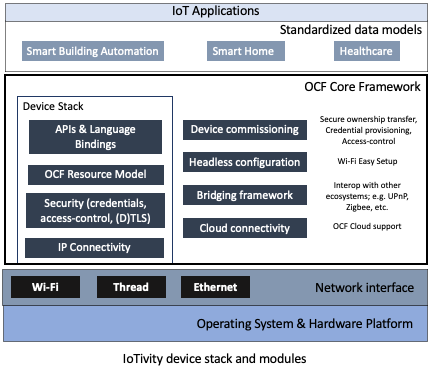Architecture
Introduction
IoTivity is an open-source, reference implementation of the OCF Secure IP Device Framework.
The OCF Secure IP Device Framework provides a versatile communications layer with best-in-class security for Device-to-Device (D2D) and Device-to-Cloud (D2C) connectivity over IP. IoT interoperability is achieved through the use of consensus-derived, industry standard data models spanning an array of usage verticals. The OCF Secure IP Device Framework may be harnessed alongside other IoT technologies in a synergistic fashion to lend a comprehensive and robust IoT solution.
Please review the following resources for more details:
The IoTivity project offers device vendors and application developers royalty-free access to OCF technologies under the Apache 2.0 license.
IoTivity stack Features

-
OS agnostic: The IoTivity device stack and modules work cross-platform (pure C code) and execute in an event-driven style. The stack interacts with lower level OS/hardware platform-specific functionality through a set of abstract interfaces. This decoupling of the common OCF standards related functionality from platform adaptation code promotes ease of long-term maintenance and evolution of the stack through successive releases of the OCF specifications.

- Porting layer: The platform abstraction is a set of generically defined interfaces which elicit a specific contract from implementations. The stack utilizes these interfaces to interact with the underlying OS/platform. The simplicity and boundedness of these interface definitions allow them to be rapidly implemented on any chosen OS/target. Such an implementation constitutes a “port”.
- Optional support for static memory: On minimal environments lacking heap allocation functions, the stack may be configured to statically allocate all internal structures by setting a number of build-time parameters, which by consequence constrain the allowable workload for an application.
- C and Java APIs: The API structure and naming closely aligns with OCF specification constructs, aiding ease of understanding.
Next steps
Visit the Getting Started guides
Review the Documentation
Go to the source